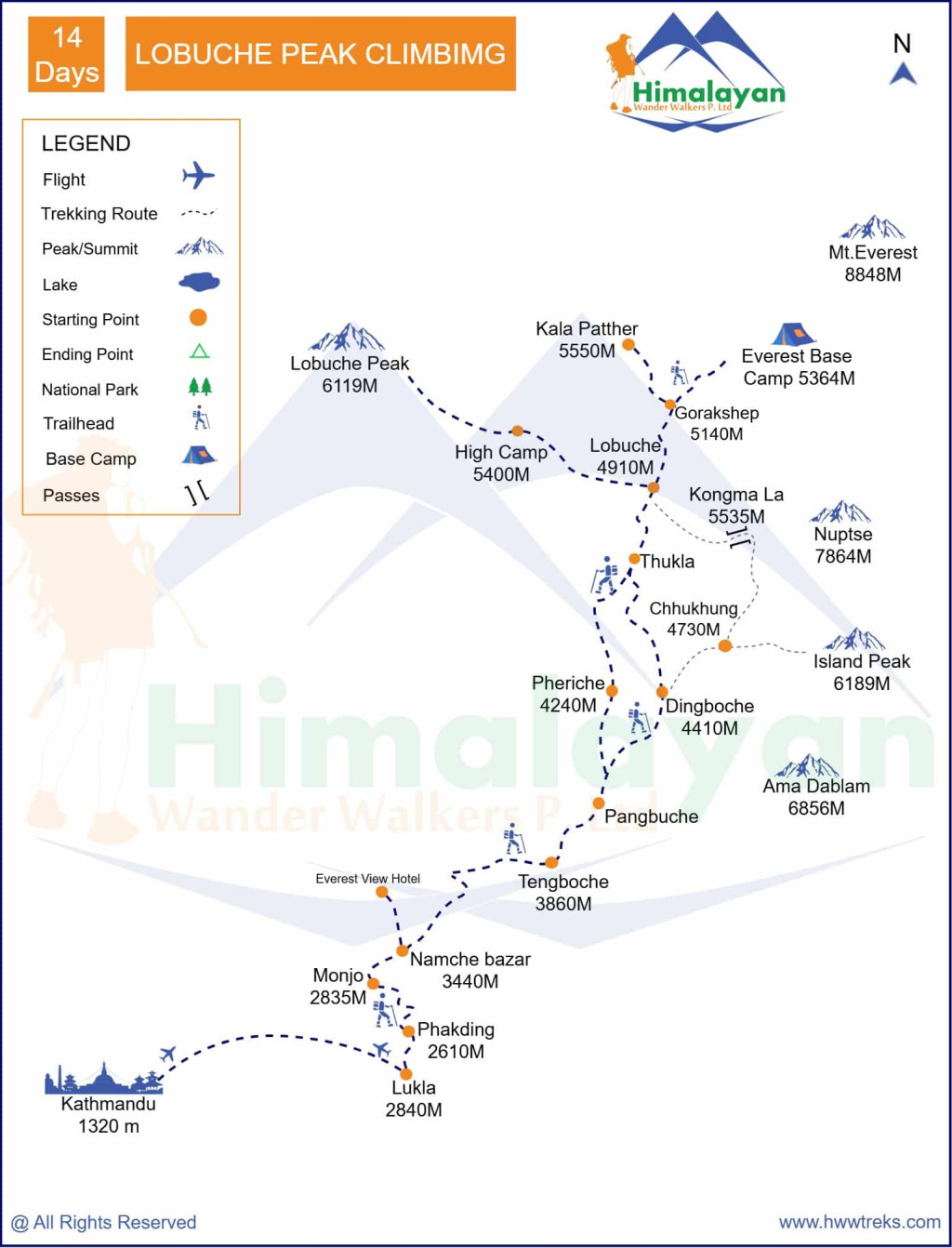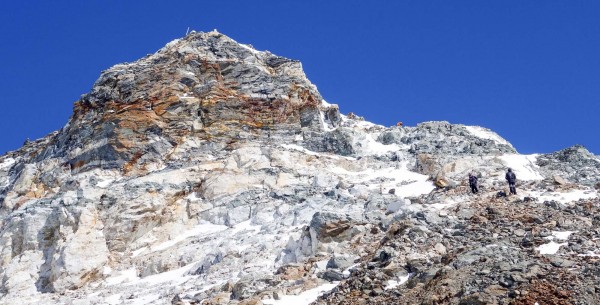Important Information
Region
Peak climbing and Expedition
Duration
14 Days
Max Altitude 6145m
Best Season March to May, September to November
Grade
Level Level 3
Group Size
2 - 12 people
Transportation 2 way flight
Lobuche/Lobuje Peak, a stunning trekking peak nestled in the Khumbu region of Nepal, is the perfect adventure for those looking to experience the thrill of high-altitude mountaineering. Located near the towering Mount Everest, Lobuche has two main summits: Lobuche East (6,119 meters to 20,075 feet) and Lobuche West (6,145 meters to 20,161 feet). Whether you're an experienced mountaineer or a beginner, eager to take on your first peak, Lobuche offers both challenges and unforgettable views.
Lobuche East is often chosen by climbers as a stepping stone for acclimatization before tackling Everest, but it has its incredible challenges. Reaching the summit requires technical climbing skills, including the use of ice axes, crampons, and ropes, and a good understanding of how to navigate snow slopes and crevasses. But don't let that intimidate you! With proper preparation, guidance, and support, Lobuche is achievable for climbers of varying skill levels.
From the top of Lobuche, you’ll be treated to jaw-dropping views of some of the world’s highest mountains, including Everest, Lhotse, Nuptse, and Pumori. The landscape is as rugged as it is beautiful, with jagged peaks, glaciers, and vast, snow-covered expanses.
What to Expect During the Climb
Climbing Lobuche is no easy feat. You'll need physical strength, mental determination, and the right equipment. It’s important to have gear like ice axes, crampons, and climbing ropes, as well as solid experience with using them in alpine environments. That said, the climb is achievable for anyone with a reasonable fitness level, and many climbers find it an excellent introduction to higher-altitude mountaineering.
While the physical challenge is significant, the mental and emotional rewards are worth every ounce of effort. As you ascend, the sense of accomplishment grows with every step, and the moment you stand at the summit, looking out over the Himalayan giants below, will be one you’ll never forget.
If you are looking for a different itinerary than the itinerary here, please Customize Your Trip.
Include
Your Standard meals(Breakfast, Lunch,and Dinner) during trekking
All Trekking & Climbing permit
Necessary Trekking, Climbing equipment
Domestic Flight Ticket(Kathmandu to & from Lukla)/ domestic airport tax
All accommodations in lodges/tea houses during the treks.
Trek arrangements with tents, cook, and porter/s (NMA Registered Climbing Guide for trekking and climbing) .
Arrangement of Emergency Helicopter service which will be paid by your Travel insurance company.
Medical supplies (first aid kit will be available).
All government taxes & service charge
Exclude
Nepal entry visa and International flight ticket
Travel insurance
Lunch and dinner in kathmandu
Climbing boots
All Bar Bills and personal expenses( phone call, laundry services, battery recharges, bottles of water, hot water,shower)
Tips for your trekking guide & porters at the end of the trek
Route Map

Important Information
CHECKLISTS FOR LOBUCHE PEAK CLIMBING
- Valid passport (valid for six months from the date of your trip)
- MasterCard, Visa Credit, and Debit Cards are accepted in Nepal. However, some cash is highly recommended.
- Mobile (if your cell phone is from CINGULAR USA or ATNT (USA) operators, then your cell phone will work in Nepal.)
- Clothing (Layered clothes, windproof and waterproof jackets, fleece pullovers, thermal base layers, hiking pants, shorts, headwear, footwear, and other items according to your needs)
- Personal Items and Toiletries (First-Aid Kit, Iodine tablets or a UV purifier to treat water, Sun Protection)
- Travel and Health Insurance
- Trekking gear and equipment(if you have your own trekking gear and equipment, such as trekking poles, sleeping bag, and shoes, then you can bring them; else you can rent them in Thamel, Kathmandu). Read more for trekking gears and peak climbing gears.
Why Lobuche Peak Is a Must-Do
The combination of stunning natural beauty, rich cultural experiences, and the challenge of a technical climb makes Lobuche Peak a highly rewarding adventure. Whether you're a seasoned mountaineer or someone just starting, this peak offers the opportunity to push your limits and experience the Himalayas in a way few other places can offer. If you’ve dreamed of climbing a Himalayan peak and standing on top of the world, Lobuche is waiting for you. With proper preparation, the right gear, and a bit of determination, you’ll conquer this incredible mountain and take home memories that will last a lifetime.
Best Time to Climb
The best times to climb Lobuche Peak are during the spring season (March to May) and the autumn season (September to November). The spring season is especially popular due to favorable weather conditions with less rainfall and very little snowfall. This is when most trekkers visit, so you'll have plenty of fellow adventurers to share the experience with.
If you're looking for a quieter, more serene experience, winter can also be a great time to climb. Although the temperatures will be colder, the crisp, clear air offers stunning views of the mountains, and there are fewer climbers around, which means more solitude and peace.
Frequently Asked Question
Yes, you can customize this package to fit your schedule and preferences. Whether you want to modify the trek's length, add rest days, or add side treks along the route, we'll collaborate with you to tailor the experience to your liking. Just let us know what you're looking for, and we'll make the necessary adjustments: "Customize Your Journey."
Lobuche Peak is located in the Khumbu region of Nepal within Sagarmatha National Park. It sits near Lobuche village in the Everest region, close to the Khumbu Glacier. From Lobuche village, it takes about 2-3 hours to reach Lobuche Peak Base Camp, making it easily accessible during the Everest Base Camp trek route.
Lobuche Peak has two summits - Lobuche East stands at 6,119 meters (20,075 feet) and Lobuche West at 6,145 meters (20,161 feet) above sea level. Most climbers attempt Lobuche East as it's more accessible and classified as a trekking peak. The summit offers spectacular views of Everest, Lhotse, Nuptse, Ama Dablam, and Pumori.
Yes, an experienced climbing guide is highly recommended and often mandatory. Nepal's regulations require certified guides for most trekking peaks for safety and legal compliance. Guides provide route finding, technical instruction, safety management, emergency response, and handle permits.
The best seasons for Lobuche Peak climbing are spring (March to May) and autumn (September to November). Spring offers stable weather and warmer temperatures but can be crowded. Autumn provides crystal-clear mountain views and stable conditions. Winter is extremely cold and challenging, while monsoon season (June to August) brings heavy snow and poor visibility, making climbing unsuitable.
Lobuche Peak climbing costs about $1,900.00 (All-inclusive price) per person. However, the total cost depends on several factors, including season (peak season costs more than off-season), service level, transportation (flight or land transport), guide and porter ratio, and many more. Contact us for a customized quote based on your specific preferences and travel dates.
You should be capable enough of hiking 6-8 hours daily for consecutive days while carrying a backpack (although all your heavy bags will be carried by porters if you have asked for any). Train with cardiovascular exercises for 3-4 months beforehand and some other regular exercise to keep your body fit for altitude changes.
Start physical preparation 4-6 months early with cardiovascular training, strength exercises, and weighted backpack hiking. Practice with mountaineering equipment especially with crampons and ice axes. Mental preparation includes route research, developing coping strategies, and managing expectations.
Usually, altitude sickness is common above 2,500 meters of elevation and since Lobuche Peak climbing will take you to 6,119 meters, you might face some symptoms of it including headaches, nausea, and fatigue. Prevention requires proper acclimatization with gradual ascent and rest days. Stay hydrated, avoid alcohol, and follow the "climb high, sleep low" principle. Most itineraries include acclimatization days in Namche Bazaar, Dingboche, and Lobuche.
Yes, peak climbing insurance is essential. Your policy must cover high-altitude mountaineering activities up to 6,200 meters and include emergency helicopter rescue and other medical treatment coverage. The insurance protects you against altitude sickness and any medical emergency. Many trekking and peak climbing agencies will ask for the insurance paper during or before your trek booking.
During trekking, the accommodation includes comfortable tea houses with private/shared rooms and varied food options whereas at Base Camp, accommodation is in tents with provided sleeping gear. Food includes dal bhat, noodles, soups, with options becoming limited at higher altitudes.
For Lobuche Peak climbing, the essential gear includes mountaineering boots, crampons, a harness, a helmet, an ice axe, a down jacket, waterproof layers, warm gloves, glacier glasses, and a 4-season sleeping bag (-20°C rated). Technical equipment, like ropes, is provided by climbing companies. Many items can be rented in Kathmandu or Namche Bazaar. Read more about peak climbing gear and equipment.
No questions found matching your search. Try different keywords or browse all questions above.
| {{type.min}} - {{type.max}} Pax {{type.name}} - {{type.desc}} | {{type.display_price}} per people |
Extra prices:
Let us help you decide Inquiry
You might also like

- 15 days
- Peak climbing and Expedition
Island Peak Climbing
Imja Tse, Island Peak (6160m) is the best trekking peak in the Everest region for novice climbers to develop the skills of climbing on snow and ice at high altitudes.Island Peak is the number one rating climbing peak in the Everest Region of Nepal which has (6,189m/20,305ft) heights. It is also known...



